Luneville crochet embroidery has become a popular hobby in France since 1865. Since then, creating beautiful patterns from thin threads has become an art. For beginning craftsmen, it is important to familiarize themselves with the basic techniques, understand how to work with a hook correctly, and learn how to select materials in order to create high-quality embroidery.
Features of the Luneville hook and working with it
The Lunéville hook is a special device for fine embroidery on light fabrics. The tool does not look like a crochet hook or a tapestry needle, it is something in between. The hook has a wooden handle with a locking mechanism for the metal part.
The working part of the tool is made of metal. The thin base has a bend at the end, resembling a hook. The bend angle is sharpened to easily pierce the fabric. There are special recesses on the hook where it is attached to the handle.
The hook has several features:
- The tool should be used on fabric that is pre-stretched in a frame. To embroider quickly and efficiently, you need 2 free hands.
- Learning how to crochet with beads or sequins requires skill. Even experienced craftsmen have difficulties.
- Each type of fabric requires a hook of a specific size.

Some embroidery fragments cannot be decorated using this device.
What materials and tools are used in the work?
To create beautiful Luneville embroidery, it is not enough to have a hook and fabric.
To work you need:
- thin needles of different diameters;
- hoops and frames with holders to free your hands;
- strong threads of different colors;
- scissors;
- special markers for marking;
- beads, bugles and sequins for decoration;
- stencils.
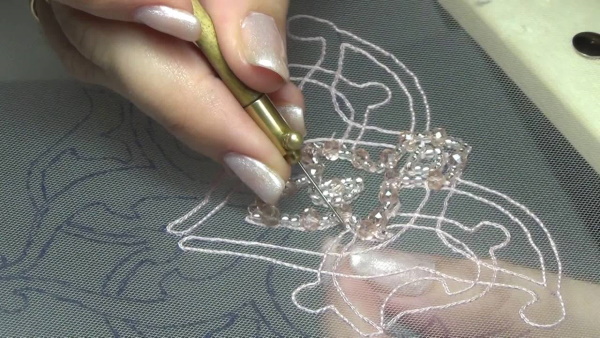
It is important that all materials are high-quality and clean. Lunéville embroidery is a very delicate work that does not tolerate blots and mistakes. Stencils can be schematically drawn by hand or taken from the Internet.
Choosing a hook
The hook for Luneville embroidery must be selected correctly. The thickness of the needle depends on the type of threads, as well as the density of the fabric. For comfortable work, it is important to purchase high-quality material. Among the world's manufacturers, experienced craftsmen note that the most reliable tools are made in France, Germany and America.
Beginners need to know that hooks of different manufactures can have the same number, but differ in thickness. French hooks are considered the most popular, so further descriptions with numbers will be based on them.
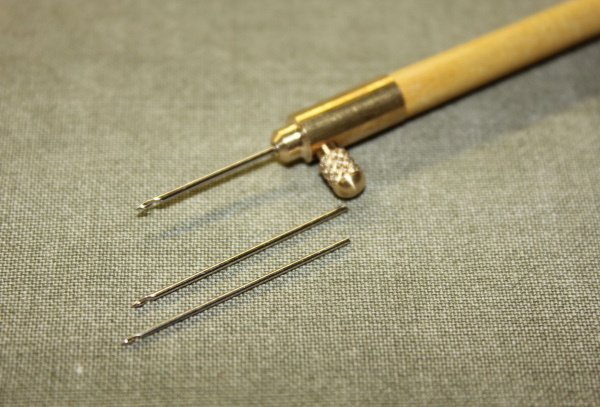
By looking at the table below, you can easily determine the appropriate hook for different types of thread:
| No. 70 | No. 80 | No. 90 | No. 110-120 |
| Fine threads and fixing of jewelry. | Fixing sequins with thin threads, embroidery with lurex, viscose thread and fastening the hem. | Sewing threads, floss, silk, metallic. Fixing beads and beads. | Decorative threads, sewing threads, floss. |
Hooks can be purchased at craft stores or ordered online.
Selecting textiles for the base
Luneville crochet embroidery for beginners and experienced craftsmen can be done on fabrics of different densities.
The most popular types of fabric are:
- Crepe used for sewing curtains.
- Polyester organza.
- Combined organza (silk + cotton).
- Silk organza.
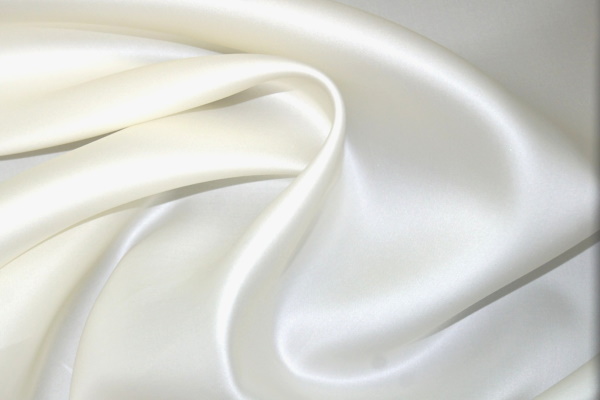
Embroidery can also be done on Italian mesh, which is called "net for naked dresses." This material is medium in hardness, does not stretch and consists of small hexagonal cells. For embroidery of a pattern with beads and beads, it is recommended to take a dense fabric, for example, velvet or cambric.
It is important to pay attention to the quality of the fabric. Before buying, you need to inspect the fabric, it should not have any snags or small holes.
Selection of threads
Fine embroidery requires strong threads. Their structure should not be too soft, otherwise a thin needle will split the thread or break it. Knots do not hold well on too smooth threads, they slip and change their location, or even unravel. Needlewomen use materials from proven brands.
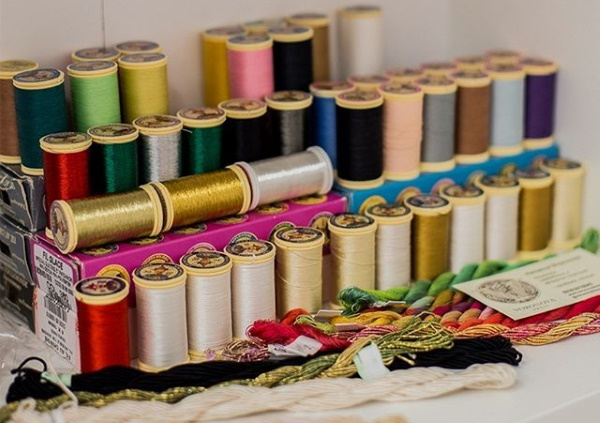
In the table below you can find the names and characteristics of threads suitable for Luneville embroidery:
| Brand name | Characteristics |
| Fill Au Chinois | The threads are thin and strong. They shimmer in the light and do not tangle. The structure is dense. Therefore, they do not split or break. The manufacturer offers a wide range of colors, from bright to pastel shades. |
| Madeira | There are 2 types: cotton and silk. The first option is intended for textured embroidery and it is more difficult to work with such a thread. Silk threads are suitable for smooth embroidery. |
| Gutermann | Experienced craftsmen advise beginners to work with threads of this company No. 110. The material is strong and slippery, the knots hold tightly. |
| Adele | These threads are produced specifically for Luneville embroidery. The palette consists of different metallic shades. The threads shine well, and the range includes "chameleon" colors. |
It is difficult to work with simple sewing threads. They are mainly used to fix beads and seed beads. Viscose threads are considered the most suitable for embroidery. They are strong and do not tend to tangle.
Master class of Luneville embroidery for beginners
Luneville crochet embroidery for beginners is based on learning the main techniques and methods. First, you need to practice on separate pieces of fabric. Experienced craftsmen advise beginners to try different fabrics, hooks and threads to find the most suitable options for themselves. Below are detailed descriptions of several embroidery techniques.
Tambour suture technique
The chain stitch is a line of loops threaded into each other. This technique is most often used to create contours and intricate patterns.
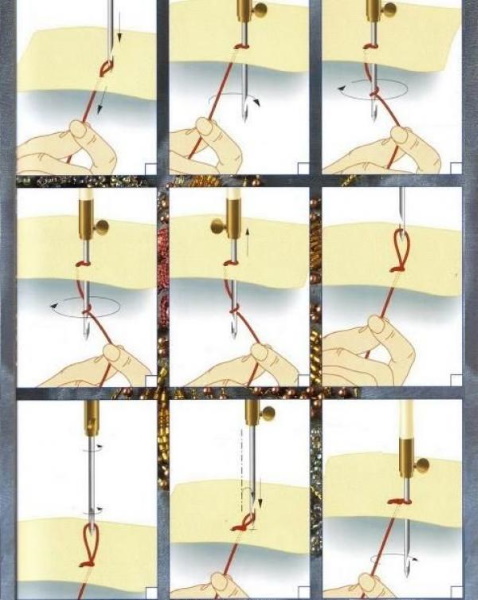
How to make such a seam:
- The hook is held vertically and the fabric is pierced in the place where the embroidery will begin.
- It is important to keep track of which way the hook bend is facing. Experienced needlewomen recommend using the handle of the screw clamp as a guide. The needle is installed in advance so that the hook bend and the screw "look" in one direction. When piercing the material, the hook should "look" forward.
- The thread is brought from below, under the fabric. It needs to be slightly pulled by throwing it over the index finger and thumb. The end is held with the little finger.
- The thread is hooked and carefully pulled to the surface. When the hook approaches the fabric from below, it should be turned in the opposite direction, towards yourself.
- The next puncture is made, stepping back from the first 1-4 mm. Beginners need to make larger stitches so that the threads are clearly visible.
- The hook is turned away from you again, and the thread is wrapped around the needle once under the fabric, counterclockwise.
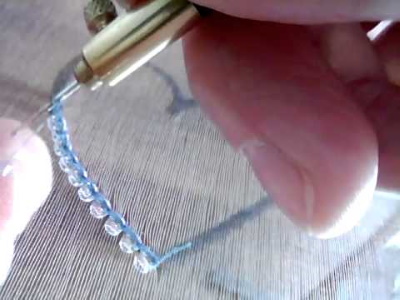
- The thread needs to be brought to the surface again by smoothly turning the hook towards you.
- The resulting loop is pulled out and the position of the hook is immediately smoothly changed, turning it forward.
- The third puncture is made in the same way. The embroidery continues until the end.
It is very important to monitor the position of the hook and remember to turn it. If the tool is constantly directed in one direction, uneven holes will form in the fabric and the threads will break.
How to avoid holes?
Embroidery with a Luneville hook may seem difficult for beginners, as holes and snags may form on thin fabric during the process. To avoid this, you need to carefully remove the hook. If the tip gets caught in the fiber, do not pull or jerk the tool upwards under any circumstances.
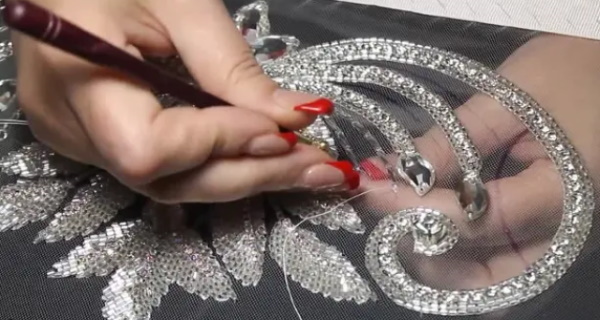
The hook should be pulled out from the wrong side to the right side smoothly. It should be held correctly and turned in the right direction. If the fiber starts to delaminate, the tool should be smoothly lowered back, the fabric should be adjusted with your fingers and the thread should be carefully pulled out again.
Bead embroidery technique
Sometimes beginners find it difficult to learn how to sew beads with a crochet hook, so they use a thin needle. Experienced craftsmen recommend not to ignore this method of decorating products. Embroidering with beads using a hook is much more convenient and faster, the main thing is to practice.
To start, you need to take larger beads, for example, 9\0. Usually they are not used for finished works, but they will come in handy for developing the skill.
Step by step instructions:
- The thread needs to be secured to the fabric. To do this, make 1 puncture 2 mm in front of the starting point of the embroidery. Pull the thread through and hold it with the fingers of your right hand. Make the next puncture at the starting point and hook the thread from below, bring it out. Then stitch with small stitches, making 1 step forward and 1 step back. Tighten the knot.
- The beads are strung on the end of the thread that remains on the wrong side. The current wrong side will be the front side in the future, so the beads will be attached there.
- Now the needle is inserted downwards, but before hooking the thread for withdrawal, 1 bead is carefully fed with the index finger of the left hand. It needs to be moved as close to the fabric as possible, and then a regular chain stitch is made.

This is how bead embroidery is created. The stitches are repeated until the work is completed. In the same way, bugle beads, chopped beads and small beads are strung onto the thread. When the novice master learns to work carefully with large beads, you can move on to material of sizes 11\0 and 13\0.
French embroidery technique
The French technique allows you to fill the outline of the design with a tambour stitch so that you get a structure reminiscent of satin stitch embroidery. This method is used to create colored Luneville embroidery. Beginners should try to make a smooth transition of colors, so for work you need to take threads of similar shades, for example, blue and light blue.
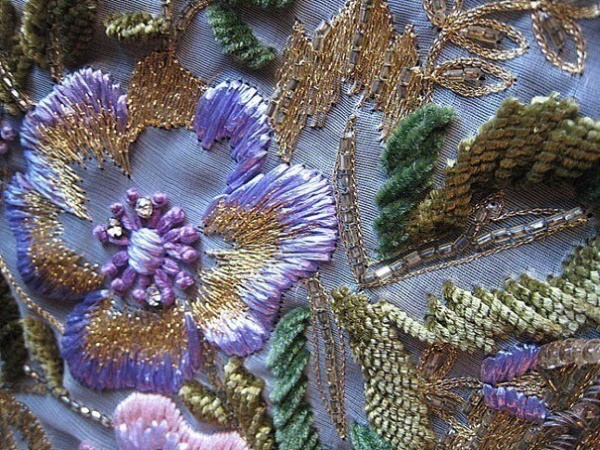
How to work in French technique:
- Beginners need to practice filling simple shapes, for example, a 3x3 cm rectangle. It is transferred to a stretched fabric.
- The figure needs to be filled lengthwise, so the needle is inserted into the lower right corner. The blue thread is secured with a knot.
- The first row, that is, one of the sides to the middle is stitched with a tambour stitch. The last loop in the row should be slightly larger than the others, so it is pulled out and the hook is returned back, starting the 2nd row from the back side.
- Then use regular stitches, turn around and do the 3rd row, where the last stitch is also pulled out.
- The extended loops should not be even, they should be placed lower and higher.
- When half of the rectangle is completely embroidered from edge to edge, take the blue thread and do the same work on the other side.
- The extended loops should be placed in the spaces between the blue ones.
You should get a rectangle in the middle of which the blue color smoothly transitions to light blue, like a gradient.
Instructions for embroidering brooches from beads and sequins
To make a brooch, you will need a stencil. The embroidery is done on a thin transparent fabric, experienced craftsmen advise buying a rigid mesh that holds its shape well. The selected design is printed on plain paper, placed under the fabric and outlined with a water-soluble marker or a simple pencil.

In addition to the fabric and template, you will need:
- felt;
- cardboard;
- threads;
- beads;
- sequins;
- scissors;
- hook.
The cones are filled with beads and thread embroidery. Sequins are attached in the same way as beads, giving them the desired direction. The colors of all materials should be in harmony with each other. When the work on the mesh is finished, the embroidery is carefully cut out of the mesh, leaving 5 mm along the edges for seams.
The backing is cut out of cardboard, it will be needed to give the product, and exactly the same shape needs to be cut out of felt. Cardboard is placed between the embroidery and the felt and the halves are carefully sewn together. All that remains is to secure the clasp.
Instructions for decorating a bag-bag with beads in delicate tones
The fabric from which the bag is made should not be too thick so that the hook can easily pass through it. You also need to choose a hoop that is the right size. The bag is turned inside out, and the side on which the beads should be located is pulled onto the frame.

Next, you need to apply a schematic drawing to the material and start embroidering. Beginners should not take on complex patterns right away. It is better to come up with a composition consisting of 1 line, for example, a floral motif with ornate stems and simple petals and leaves. It is more difficult to work with a finished product, so you can sew a bag yourself.
To create it you will need:
- sewing machine;
- hoop;
- patchwork fabric;
- tie cord;
- tailor's pins.
For embroidery you need beads that match the color, for example, white, beige and emerald will suit pink fabric. Threads of similar shades and a hook.
Instructions:
- A rectangle with seam allowances and grooves for the lace is cut out of the fabric. For a small product, the pattern size is 15x38 cm.
- One side is tucked into a hoop, a drawing is applied and the pattern is embroidered.
- After finishing the embroidery, fold the rectangle in half with the wrong side facing out and stitch the sides so that 3-4 cm remain on top.
- The remaining edges are folded, secured with tailor's pins and stitched. Then the side seams are stitched to the end, leaving openings in the groove on both sides.
- They thread the cord through and tighten it.
The tote bag decorated with Luneville embroidery is ready.
Luneville crochet ideas with diagrams and pictures
Embroidery with Luneville hook for beginners, after persistent training becomes more understandable and simple. When stitches began to be obtained quickly and evenly, ideas for creating full-fledged patterns are needed. Most often, needlewomen perform their first works in the form of lace patterns with floral motifs.
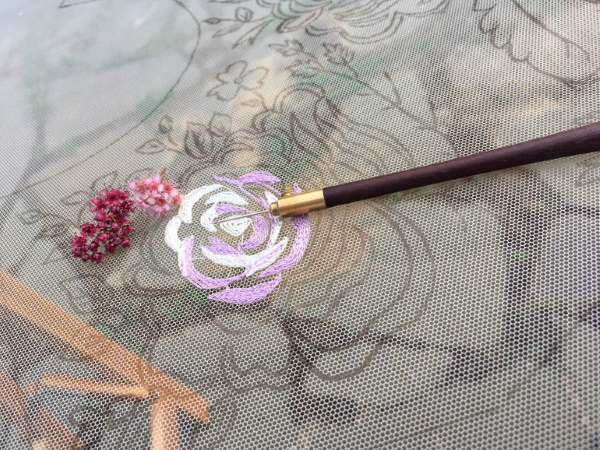
You can draw the patterns for transferring the design yourself, or print them on plain paper and then transfer them to the fabric. First, you need to pay attention to the outline patterns. These patterns only contain outlines. They are used to embroider with a tambour stitch or beads in 1 row. Working with such stencils will help you learn to maintain proportions and embroider smooth curves.
Gradually, you can move on to contours where there are more lines and they intersect with each other. When starting a new embroidery, you need to try to take a drawing a little more complex than the previous one in order to practice your skills. In combined styles, where French and tambour techniques are combined with the addition of sequins and beads, you can work after the contour patterns begin to seem very simple.
Ideas for clothing decoration
The design is transferred to clothes made of thick fabric by cutting it out from the mesh. The finished embroidery is sewn onto the items. Luneville crochet can only be used on suitable materials. If the clothes are made of cotton, chintz, jersey or chiffon, you can embroider directly onto them.

Thin blouses can have beautifully decorated collars and cuffs. Knitted T-shirts will be decorated with patterns in the French technique. An unusual beaded pattern can be sewn onto the pockets of jeans. But most often, Luneville embroidery is used to decorate dresses. Hems are embroidered with lace and floral patterns are made from beads and sequins.
This type of embroidery looks especially beautiful on wedding dresses. Professional couturiers often resort to this method of decoration, and more expensive dresses are decorated not with simple beads, but with precious stones.
Tips for needlewomen
To master embroidery with Luneville crochet faster, you need to follow several recommendations:
- Eyes need to rest, so every 40 minutes of work you need to take a break for 10-20 minutes. It is best to do special exercises at this time that will reduce eye strain.
- When mastering the first ties, it is not recommended to use black threads on white fabric. Such a contrast makes the eyes strain a lot. It is better to take threads of pastel shades, blue, pink, purple for work.
- If the seam is not successful, it can be carefully unraveled. The holes should be smoothed out with your fingers, and it is better to use fresh thread for a new attempt.
- Since the fabric for the work is transparent, the background behind it can affect the strain of the eyes. To correct the situation, you can put a white towel on your knees, and if the embroidery is made of white threads, then vice versa, a dark one.
- To ensure that the fabric on the hoop is stretched sevenfold and does not slip, you can put small pieces of felt between the frame and the material. This will secure the material more securely.
- When sewing beads, do not place them too close to each other. Due to the tension of the thread, after removing the fabric from the hoop, the pattern may become deformed.
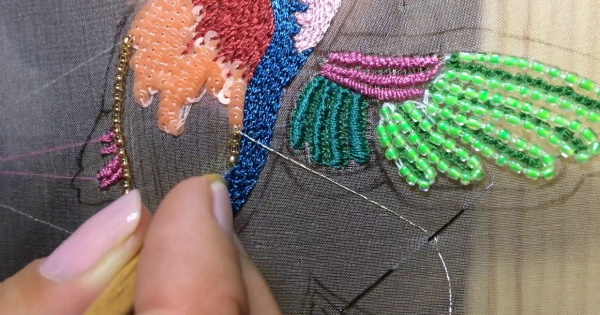
It is important for beginners not to rush. Embroidery with Luneville crochet requires patience and accuracy. In order to create beautiful patterns, you need to practice hard, select high-quality material and follow the recommendations of experienced craftsmen.
With the right approach, embroidery in the Lunéville technique can become not only a pleasant hobby, but also a way of self-expression, and also bring in additional income.
Video about Luneville crochet embroidery
How to do Luneville crochet embroidery:
